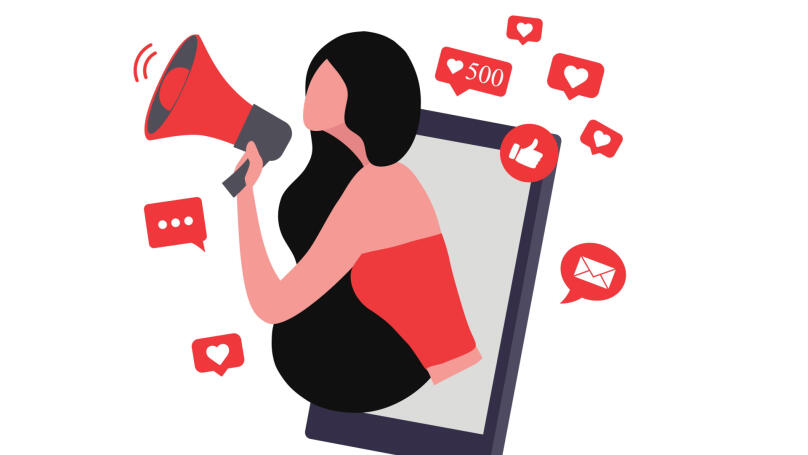Influencer marketing

What is influencer marketing, and how does it work?
Influencer marketing can be defined in many ways, but it always means promoting goods and services through influencers. They are popular bloggers and celebrities, as well as experts in a certain field, who are active on social media and have their own audience, for example, on Instagram, TikTok, Facebook or Twitter. These platforms are essential for implementing influencer strategies. Influencers are also sometimes referred to as "influence agents" since they can influence their followers and manage their opinion.
Thus, influencer marketing draws the attention of a new audience to the brand. The process goes like this: the company chooses the most suitable blogger or celebrity to advertise their products and negotiates to place an ad. On their blog or social media pages, the influencer talks about the brand and its product in a particular way, encouraging the audience to try it too. Typically, followers perceive such advertising more loyally, seeing it as advice or a recommendation.
The Benefits of Influencer Marketing
Obviously, influencer marketing is effective because the mass audience and the majority of buyers really listen to the opinion of people they find important when picking a particular product. Representatives from business intelligence company Morning Consult Pro claim that more than 50% of US residents only purchase products they see in popular bloggers' ads.
Moreover, people stopped believing the usual TV advertising and announcements due to the glut of their information field. At the same time, influencer marketing allows you to tactfully promote a product without using classic advertising as such. In such a situation, the impact of an influencer's opinion is the best choice for native promotion.
In addition, according to the McKinsey International Research Centre, such word of mouth increases sales twice. Furthermore, the customer retention rate as a result of implementing influencer strategies increases by 37%. Forbes analysts say that more than 90% of people tend to trust recommendations, even if they come from strangers, such as social media reviews. Thus, it helps to increase sales, profits, loyalty and customer confidence in the brand.
Influencer Marketing vs Other Types of Marketing

While working with influencers may remind you of affiliate marketing, they are completely different strategies. Affiliate marketing is based on building longer-term partnerships with well-known bloggers and celebrities or other non-competing brands. Its goal is concrete results in the form of new customers and, accordingly, an increase in income. Affiliate marketing assumes that the advertiser company pays the partner for each attracted customer, not just for advertising and promotion. In the meantime, influencer marketing primarily aims to increase brand awareness.
The differences between influencer marketing and traditional forms of advertising are obvious. Traditional marketing tends to be aimed at a fairly large mass audience, while influencer marketing is focused on a narrower circle of people who are most likely to be interested in the product offered. Due to this focus on a specific audience segment, influencer marketing creates more trust among potential customers, since people are more likely to believe the celebrities they know and love, rather than ordinary people from TV, for example.
Influencer marketing is also considered more universal than traditional marketing. It provides much more room for experimentation and allows you to attract a variety of customers via different implementation options. Traditional marketing, on the other hand, is more conservative. Therefore, influencer marketing also has a much higher return on investment (ROI). This is what they call the ratio between net profit and costs. High ROI means profitability and efficiency of investments in the company promotion.
At the same time, traditional marketing requires much more financial and other investments. Nevertheless, the influencer marketing strategy can be implemented in any company, regardless of its budget and scale, be it a small business, a local brand or an industrial enterprise. This became possible thanks to the development of blogging and the emergence of a huge number of various bloggers. Therefore, the advertising prices can be more than acceptable. In addition, you can collaborate with novice bloggers and advertise with them for a fee and by barter. It all depends on the type of influencer.
Types of Influencers

Influencers are divided into several types depending on how many followers they have and the level of their blog audience's engagement. Some influencers have large audiences spanning multiple demographics. At the same time, other bloggers boast smaller but more targeted and engaged communities. Knowing what each type of influencer has to offer an advertiser in terms of reach, engagement, and cost is key to choosing the right influencer to promote your brand.
So, there are the following types of influencers:
-
Celebrities
These people are known throughout the country and even the world. They may be actors, musicians, artists, athletes, famous businesspeople, or other public figures. Their fame makes it easy for them to reach out to a wide range of people, which is perfect for massive marketing campaigns to spread the word about the brand. A striking example of such an influencer is the Portuguese football player Cristiano Ronaldo, who regularly publishes advertising posts on his Instagram. He promotes Jacob & Co watches, Theragun massager, Mercurial Dream Speed sneakers and many other products, such as perfume, shampoo, skin care cosmetics, and even a delivery service. Sure, these mega-influencers can give your brand unparalleled exposure, but partnering with them can be incredibly costly. Moreover, their audience is extremely broad, which may make engagement rates less high than those of influencers with fewer followers.
-
Global influencers
These are bloggers with an audience of over one million people. Collaborating with them involves a more targeted approach to the audience since their followers usually have common interests. For example, Japanese streamer and Twitch user Pokimane, who has over 4 million followers, advertised Nissin Noodle live. During the stream, where the girl played role-playing and fantasy games, she cooked and ate Nissin Noodles.
-
Macro-influencers
Their audience includes over 100,000 but less than a million followers. Ads from such bloggers are more affordable, but this does not mean that they will be less effective. Studies show that the macrobloggers' audience is 60% more engaged in their content than that of the more famous and popular celebrities. For example, YouTube blogger Ziovo, who talks about various programmes for improving computer performance, video editing, creating presentations, infographics, and so on, has posted an advertisement for the Canva graphic design service on his channel. The video has got more than two million views, while Ziovo has about 400,000 followers.
-
Micro-influencers
Micro-bloggers have from 10 to 100 thousand followers. In fact, this is the most profitable type of blogger in terms of price-quality ratio, that is, the result. According to Upfluence, micro-influencers with less than 15,000 followers show the highest engagement rates. This pattern can be traced on all major platforms: Instagram, YouTube, TikTok, and Twitter.
-
Nano-influencers
These are the influencers who have the closest and most trusting relationship with their followers because they have less than 10,000 of them. Although they offer the least reach, nano-influencers can be great partners for companies targeting specific communities and groups of people. Additionally, followers trust such bloggers way more than global influencers who post ads almost daily. For example, blogger Abigail Brooks has less than a thousand followers on Instagram yet promotes local fashion brands.
Stages of Influencer Marketing

For influencer marketing to be the most effective and for the company to achieve high ROI, thinking over the stages of the marketing plan is essential.
Stage 1. Defining the main goal and budget of the company
First of all, you need to decide what goals the company wants to achieve by implementing an influencer marketing strategy. It could be:
-
increasing brand awareness;
-
informing the audience about a new product and drawing attention to it;
-
sales promotion;
-
boosting audience engagement;
-
increasing customer loyalty and brand confidence;
-
improving the company's reputation.
After defining the goals and objectives, you should consider what kind of budget the company has. If a nano-influencer publishes your advertising post, you can offer them a barter: for example, the blogger will talk about a new product and receive it for free in return. However, if you want to collaborate with global influencers or celebrities, you will need to pay a lot of money for one advertising post. For example, an Instagram ad from Cristiano Ronaldo costs over $1.5 million. Therefore, advertisers should decide whether it is worth investing a lot of money in celebrity advertising posts or whether advertising from micro- or nano-bloggers will be the most appropriate. Having decided on how much money the advertiser is willing to spend on placing advertising posts, you can proceed to the next step.
Stage 2. Researching the market and picking an influencer
We have already specified what types of influencers there are. However, in addition to the budget, the number of followers and their engagement level, there are other criteria for selecting influencers. For example, the target audience of a blogger. Advertising in their profile will attract followers only if they share the values that the advertiser preaches. To understand what kind of audience a blogger has, you should study their followers, especially if the company specialises in some thematic rather than general consumer products. There are special tools for studying the accounts' audience and measuring engagement. For Instagram, these are Epicdetect or trendHERO. You just need to enter the blogger's nickname and get detailed data on their audience. This is exactly how you can detect cheat likes and comments from bots. You should also ask the influencer for statistics on the publications' reach.
In addition, the very personality of the blogger and their media behaviour matter. Each company has its own tone of voice, that is, a unique style of brand communication with its target audience, principles that employees adhere to at all levels, and channels of interaction with customers. It is also important that the blogger with whom the brand decides to collaborate follows similar principles. You should study how they respond to comments and interact with their audience. Advertisers do not need their reputation to suffer if an influencer is used to giving questionable statements.
Before you offer to work with an influencer, you should look at their social media accounts and pay attention to the number of likes, comments, and reposts, as well as the influencer's manners and behaviour. After that, you can proceed to the next step.
Furthermore, you should take into account the specifics of the company and the size of the market before choosing an influencer. Brands can differ depending on how they function and which customers they target. Influencer marketing can be the most popular and effective in such business models as:
-
B2C - it implies a relationship between a company and individuals, that is, ordinary consumers. Influencer marketing is focused on this particular model of business interaction with customers since virtually any blogger can be an influencer.
-
B2B, or business-to-business. In this case, the company provides its products or services not to a mass audience, but to other companies, so an influencer in business and commerce will do.
Once a company has selected the most appropriate influencer based on various criteria, such as the number of followers, audience engagement levels, the influencer's reputation and market state, they can move on to the next stage.
Stage 3. Defining the cooperation format and picking a platform
Depending on the goals and objectives of the company, as well as the budget and requirements of the influencer, it is necessary to determine the cooperation format. This can be a one-time placement of an advertising post or story on Instagram with a mention of the brand and its products, advertising integration on YouTube or Twitch, or a video on TikTok. A different format of cooperation is regular, that is, it includes a series of advertising integrations that the influencer publishes over a certain period. Furthermore, advertising content can be posted on the blogger's several social media pages at once. In addition to the platforms mentioned above, many influencers use Twitter, Facebook, and Telegram. It all depends on what social networks most of the brand's customers use.
Stage 4. Developing promotional content
Of course, an advertiser company represented by a marketer can prepare an advertising post with a description of its brand and its products, focusing on the influencer's communication style with their audience. However, the best way to create ads for an influencer is to have the influencer develop the content themselves so that the ad looks natural, like a sincere recommendation. By the way, to do this, you should allow the influencer to use the company's products, even if your cooperation is based on a fixed payment rather than barter.
Stage 5. Analysing influencer marketing performance
After conducting an advertising campaign, you need to analyse its results: whether it was possible to achieve the goals set and whether everything was implemented as planned. When evaluating performance, you should focus on metrics such as:
-
coverage, that is, how many potential users learned about the brand/product as a result of the blogger's advertising posts;
-
engagement, that is, how many likes, reposts, comments and mentions were left by followers under the advertising post;
-
the number of clicks the blogger's followers made by visiting the brand's website or other official social media pages.
It is easiest to track and analyse all the results if the company has prepared special promotional codes or coupons for influencer marketing. These loyalty program tools allow customers to get a discount on a certain product or group of goods, attract a new audience, promote brand awareness and maintain a positive reputation. Moreover, they help track the number of purchases made after placing advertising posts, regardless of the platform, the presence of active links redirecting to the company's website, and so on.
Depending on the results obtained, the company decides whether it will collaborate with the influencer again in the future or whether it is more appropriate to consider another blogger.
Thus, influencer marketing is especially relevant for quickly promoting a brand or a startup and advertising new goods and services. Companies can use influencer marketing to create or maintain a sense of trust among consumers, increasing their brand loyalty and attachment. The key is to choose the right influencer who shares the values of advertisers and sincerely wants to help their followers in choosing a brand, quality products and services.























